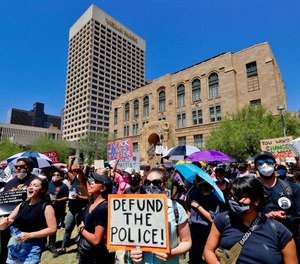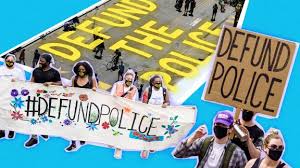As a Republic, Americans vote for the politicians they believe will represent their best interests. No doubt there has been a huge outcry from some of the public that has been vicious enough to cause politicians to seriously consider de-funding law enforcement entities. Rep. Alexandria Ocaso-Cortez (D-NY) has been one of the loudest crying for defunding of local police forces. When New York City Mayor Bill deBlasio got the City Council to cut the NYC Police budget by $1 Billion, Ocasio-Cortez famously tweeted, “Defunding the police means ‘Defunding’ not reducing.”
Despite all the threats and promises about de-funding police agencies, the devil is in the details. Few have given Americans true pictures of what law enforcement will look like in such a program, or if any type of police force will exist in that scenario. Basic police services will always be needed to respond to calls for service and violent crime. Proponents of “broken windows” policing, Crime Prevention Through Environmental Design (CPTED), and other pro-active prevention methods such as foot beat patrols and traffic enforcement, believe there should be tactics and strategies to prevent crime as well. If de-funded, you can bet most, if not all, community policing and prevention programs will suffer. And if there is such suffering, who will bear the pain? The People.
Long before the death of George Floyd, there have been calls to “de-militarize” the police. The Government 10-33 Program that awards military surplus to local law enforcement was first attacked during the Obama administration. The Urban Area Strategic Initiative (UASI) program, which helps identify and strengthen law enforcement infrastructure, has seen budgets dwindle over the years as well. The accompanying Urban Shield SWAT readiness training and exercises have been defunded. All these programs are linked to the public picture painted of the “militarization of the police.” Activists of most kinds are not always adept at painting truthful pictures. They tend to embellish to further their causes.

Despite changes to these federally funded programs, the impact on the patrol force has not been significant. Although agency budgets will no doubt be trimmed, the actual trickle down to patrol operations can be expected to be minimal.
Before dismantling police departments, city officials, councils, boards, and mayors may want to do some due diligence and speak to:
The COPS Office: The Department of Justice has valid input about the benefits of community policing grants and personnel hiring grants
Mothers Against Drunk Drivers (MADD)
The organizers behind community policing initiatives like National Night Out; human trafficking awareness groups; domestic violence, family violence, and child abuse prevention advocates; and all the many victim advocate programs and agencies that partner with police.
The End of Social Problems Policing?
Much of the negative shadow over policing is due to the social problems the police are often called to handle. Critics say police should not be the agency to deal with the chronically inebriated, drug abusers or the mentally ill. If anything good comes from the cry to defund police, maybe it will shift funding for mental health professionals to respond to calls involving the mentally ill. Calls for service for the mentally ill are significant in any American city. In 2018, a Santa Clara County Grand Jury found that 40% of all police shootings involved an individual with mental illness.
Law enforcement’s contact with the mentally ill may not always end in a shooting, but the use of force is not uncommon, which has been upheld by the courts. Still, part of the de-fund movement attacks the ability of police to handle those with mental illness in crisis. Despite efforts to train law enforcement personnel in crisis intervention and other means of communicating with those in crisis, perhaps now may be a good time to hand duties over to trained medical and psychological experts in the field. Better yet, put the mobile crisis teams in the field and have them respond directly to 911-dispatched calls for service.
Budget shifting could reallocate funds for trained unarmed outreach workers to address homeless issues, including disputes in camps. I would imagine that most line officers would gladly turn over response authority and calls for service regarding public nuisance reports. Although in reality, it would not be long before someone got hurt or stopped responding to such calls. In San Francisco over a decade ago, street sweeper trucks from the Department of Public Works (DPW) were tasked with cleaning the United Nations Plaza. After some of the DPW drivers were assaulted, they refused to drive through the plaza without a police escort.
Perhaps all external defibrillators (AED) and naloxone will be removed from patrol vehicles and given to additional EMS personnel and vehicles to actively patrol areas where public chronic drug abuse is rampant and sometimes sanctioned and supported by the local government. That will make life easier on the patrol force, which often finds their hands tied when responding to medical crises.
The concept of changing procedures and shifting responsibilities to another agency has been successful in some places. There are numerous documented past cases that when called to public places where unconscious chronically inebriated or drug-infused individuals that were found, officers would try to awaken them and transport them to a station detention cell until they sober up. Multiple in-custody deaths led to a new policy that mandated for an EMS response for those non-ambulatory individuals who could not be revived or speak coherently. The new policy was beneficial for the police and the inebriated person. The downside was an EMS ambulance was taken out of service, the cost of the service ($3,000 or more in San Francisco), and inadequate bed capacities at critical care hospital emergency rooms.
Legislated Crime Mandates
There seems to be the usual legislation of “all or nothing.” There is no message to the public to reassure them that crime and criminals will be dealt with. Do legislators understand that most crime victim legislation arises from tragedy? Do they understand the Jacob Wetterling Act? Have they heard of Megan Kanka, Polly Klass, or Adam Walsh?
Are they familiar with the Clery Act? University and college police chiefs understand their obligations of the Clery Act to provide transparency around campus crime policy and statistics. Failure to act, notify, or report crimes can result in fines of approximately $54,000 per omission. Not to mention that students need to know of crime problems and hot spots on and near their campuses.
The wounded and suffering families of these victims for which their loved ones are named after can confirm the need for a well-trained and professional police force.
Police as Firefighters
The idea of de-funding police departments is unrealistic. We have already anticipated negative impacts on public safety budgets from the COVID-19 recession, but some opportunists are seeking to redistribute budget dollars to other favored unarmed services in the medical, mental health, and social service sectors. If the intent is not to abolish law agencies altogether but to downsize their abilities and presence, police response from the station house will be reactive, not pro-active. In other words, the result will be police responding to crime after it occurs.
Experts have said that inner-city urban violence can be attributed to young men with guns who carry “payback” in their own hands rather than relying on the police for justice. Will de-funding police be the answer to the violence we routinely witness in cities like Chicago, Seattle, Portland, and Baltimore? Knee-jerk policymaking will always result in unintended consequences. Cities that are quick to de-fund police agencies may see bigger problems than the ones they currently perceive.
The problem is that major groups like Black Lives Matter who are well organized, very well funded, and who intimidate many politicians and city and state policymakers carry a really large stick in the public’s view. BLM is adamantly committed to defunding the police — ALL police — in the United States. BLM has not offered a plan for how law enforcement will exist without any law enforcement!
Most Americans in large percentages are against the complete defunding and therefore disbanding police forces. Most Americans want a revision of law enforcement agencies to assure citizens that members of police forces who integrate daily face-to-face with people have adopted through classes and instruction given by experts from public health organizations processes that will result in far less physical and verbal violence in each interaction.
Can that even be done? Is there any realistic scenario in which viable law enforcement can achieve the lofty expectations of Americans in protection? Is reducing the number of police officers while adding EMS and firemen and social workers into the mix realistic?
In most 911 calls in the nation, especially those involving health trauma, having police solely in response doesn’t happen today. Responders usually include police and fire department EMS first responders. Is that necessary?
Think about it: a 911 caller usually is NOT an expert in addressing whatever is happening on the scene. More often than not, the circumstances of such an incident are different when the response team arrives. In life and death emergency cases, having whatever resources are necessary as quickly impossible is what saves lives.
Summary
Plain and simple, reducing budget dollars or defunding police is the most ridiculous political talking point of this century! If this happens, (and it looks like it is likely in some localities) people will die needlessly for lack of ALL the emergency care that in today’s scenario is made available. Police action during many incidents will be less intrusive and comprehensive. This will certainly result in some for whom these responses are made will die. Are public officials prepared to pay the consequences for such actions?
In answer to that, just look at the recent responses to emergency situations of all kinds in Seattle, Portland, Minneapolis, Chicago, and Washington D.C. Mayors and governors of those locations have caved strictly because of political purposes. The emergencies that have occurred daily in each location have been handled poorly because politics drove the responses rather than the perceived responses dictated by those incidents. And people suffer needlessly. Is that what America

